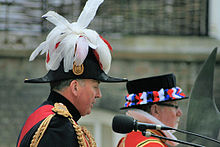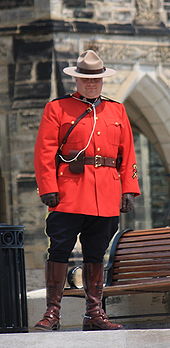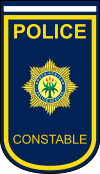Constable
Aconstableis a person holding a particular office, most commonly in criminallaw enforcement.The office of constable can vary significantly in different jurisdictions. A constable is commonly the rank of an officer within thepolice.Other people may be granted powers of a constable without holding this title.
Etymology[edit]

Historically, the title comes from theLatincomes stabuli(attendantto thestables,literally 'count of the stable') and originated from theRoman Empire;originally, the constable was the officer responsible for keeping the horses of alordormonarch.[1][2][3]
The title was imported to themonarchiesofmedievalEurope, and in many countries developed into a highmilitary rankand great officer of state (e.g. theConstable of France,in FrenchConnétable de France,who was the commander-in-chief of all royal armed forces (second to the king) until Prime MinisterCardinal Richelieuabolished the charge in 1627).
Most constables in modern jurisdictions arelaw enforcementofficers. In the United Kingdom, theCommonwealth of Nationsand some Continental European countries, a constable is the lowest rank of police officer (it is also, when preceded by the termsworn,used to describe any police officer with arrest and other powers), while in the United States a constable is generally an electedpeace officerwith lesser jurisdiction than asheriff;however, in theChannel Islandsa constable is an elected office-holder at theparishlevel.
Historically, a constable could also refer to acastellan,the officer charged with the defence of a castle. Even today, there is aConstable of the Tower of London.
An equivalent position is that ofmarshal,which derives fromOld High Germanmarah('horse') andschalh('servant'),[4]and originally meant "stable keeper",[5]which has a similar etymology.[6]
Usage by country and region[edit]
Australia[edit]

In Australia, as in the United Kingdom, constable is the lowest rank in most police services. It is often categorised into the following (from lowest to highest): probationary constable; constable; constable first class; senior constable; leading senior constable. These variations depend on the individual state or territory police force in question.
Senior constablegenerally refers to a police officer of the rank above constable, and is denoted by way of two chevrons or stripes.
TheNew South Wales Police Forcehas three grades of senior constable, namely senior constable (two chevrons), incremental senior constable (two chevrons and a horizontal bar), and leading senior constable (two chevrons and two horizontal bars). A senior constable is senior to a constable but junior to an incremental senior constable. Promotion to senior constable can occur after a minimum of five years' service (one year as a probationary constable in addition to four years as constable) and then upon passing probity checks and an exam. Incremental senior constable is attained after ten years of service automatically. One is appointed to the rank of leading senior constable on a qualification basis, but must have a minimum of seven years' service amongst other criteria in order to be eligible. Leading senior constable is a specialist position of which there are limited allocated numbers within any section/unit or local area command. If an officer is transferred to another duty type or station, the officer is then relieved of the position of leading senior constable: it is primarily a position for field training officers who oversee the training and development of inexperienced probationary constables or constables.
Within theVictoria Police,senior constable is the rank above constable, while above senior constable is leading senior constable. When first introduced into the Victoria Police, leading senior constable was a classification not a rank, somewhat like "detective"; leading senior constables were appointed specifically to assist in the training and mentoring of more junior members. The last round of wage negotiations, however, saw leading senior constable become a rank in its own right, one that a lot of members pass through on their way from constable to sergeant, though this is not strictly necessary and it is permissible to be promoted to sergeant direct from senior constable. The general form of address for both senior constable and leading senior constable is "senior", and this is acceptable even in courts.
Canada[edit]

In Canada, as in the United Kingdom, constable is the lowest rank in mostlaw enforcementservices, including theRoyal Canadian Mounted Police.[7]In Newfoundland the provincial police are theRoyal Newfoundland Constabulary,whereby all officers are addressed by the term "constable".
In addition, thechief officersof somemunicipalpolice services in Canada, notablyVancouver Police Department,carry the title ofchief constable.[8]
InCanadian French,constable is translated toagent,except in the Royal Canadian Mounted Police where it is translated asgendarme.[9]
Appointments can further be separated into:
- Special constables
- RCMP special constables are appointed for specific skills, for example aboriginal language skills. They arepeace officersunder theRoyal Canadian Mounted Police Act.
- Outside of the RCMP, special constables are not police officers but are appointed to serve certain law enforcement functions, for exampleSPCA agentsor court/jail officers.
- Auxiliary constables,or reserve constables, are volunteers with a policing agency. They generally have peace officer status only when engaged in specific authorized tasks.
- Provincial civil constables (inNova Scotia) deal with matters of a civil nature.[10]
Denmark[edit]
Within theDanish Defence,constables are the lowest rank group. The ranks ofKonstabel,OverkonstabelandOverkonstabel af 1. gradare used for professional enlisted soldiers, sailors and airmen. However,Overkonstabel af 1. gradis only used within the army, as both the navy and air force use aspecialistrank instead.[11][12]
| NATO Code | OR-3 | OR-2 | OR-1 | |
|---|---|---|---|---|

|

|

|

| |
| Danish | Overkonstabel af 1. grad | Overkonstabel | Konstabel | Konstabelelev |
| Literal translation | Senior constable first class | Senior constable | Constable | Constable trainee |
| Official translation[14] | Lance corporal | Private first class | Private | Recruit |

|

|
|||
| Danish | Marineoverkonstabel | Marinekonstabel | ||
| Literal translation | Senior naval constable | Naval constable | ||
| Official translation[15] | Able rating | Junior rating | ||

|

|

| ||
| Danish | Flyveroverkonstabel | Flyverkonstabel | Flyverkonstabelelev | |
| Literal translation | Senior air constable | Air constable | Air constable trainee | |
| Official translation[16] | Junior technician | Aircraftman | Recruit | |
Finland[edit]
In theFinnish Police,the lowest rank ofpoliceofficer is callednuorempi konstaapeli,translated into English as (junior) constable.[17]
The next rank isvanhempi konstaapelior senior constable.
The next highest rank (equivalent to a policesergeantin the English-speaking world) isylikonstaapeli(yli-"leading" ), literally "over-constable".[18]
Hong Kong[edit]
TheHong Kong Police Forcehave two ranks for constables:
- Senior constable—lead officer in a beat patrol; SPCs wear a single chevron on their shoulder above their unique identification (UI) number.
- Constable—officer in a beat patrol; PCs wear no insignia other than the unique identification (UI) number.
Senior constable is not a rank: it is merely a designation for officers who have served for 18 years.
India[edit]
Police constable (abbreviated PC) is the lowest police rank in India, belowhead constable.Generallaw and orderbeing astate subjectin India, eachstate governmentrecruits police constables. A police constable has no shoulder insignia, while a head constable has one or more stripes or chevrons, depending on the state. Since each state has its own police force, the uniforms and insignia of the police vary, though therank structureis the same. In theKerala Police,the designations for personnel in the ranks of constable and head constable are Civil Police Officer (CPO) and Senior Civil Police Officer (SCPO), respectively. Both CPO and SCPO belongs to the Kerala Civil Police Subordinate Service (KCP) and typically work in local police.[19]
TheCentral Armed Police Forces(CAPF), under theMinistry of Home Affairsof theGovernment of India,also maintain the same ranks as state police even though their jurisdiction varies considerably, with the constables recruited to the CAPF having to do duty all over India. They perform duties such as maintaining internal security,border guarding,and counter-insurgency operations andriot control.Nearly all the police constables wearkhaki-coloured uniforms, which indicate that they are police personnel.
Generally there are three types of constables in India, depending upon the unit, wing, branch or section they are attached to. Civil police constables are attached to apolice station,traffic police constables control road traffic, telecommunication constables manage communications, whereas armed police constables are attached to armed police units. The types of constables are based on nature of their duties. The Indian police constables do a wide range of duties like patrol, beat system, crime detection, escorting of prisoners and VIPs, guarding vital offices and installations, vehicle traffic control on roads, riot control, assisting civil administration during disasters, epidemics and elections.[20]Generally a police constable does his duty in his jurisdiction area, but can be assigned anywhere by his superiors depending on the situation or need. The duty hours of Indian police constables are erratic, many times without weekly time off or leave.
Police recruitment is based on a written test, plus physical and medical tests. After appointment all police constables have to undergo compulsory training; the duration of training may vary from nine months to one year depending on state. The training and duty of police is physically and mentally strenuous in India.
Norway[edit]
In theNorwegian Police Servicethe rankpolitikonstabelwas until 2003 the lowest rank in the police, the next ranks being "politioverkonstabel", "politibetjent", "politiførstebetjent", "politioverbetjent" and "politistasjonssjef", "lensmann" or "sysselmannsoverbetjent" (all officially translated as chief superintendent). In 2003, the ranks "politikonstabel", "politioverkonstabel" and "politibetjent" were renamed "politibetjent 1", "politibetjent 2" and "politibetjent 3", where "politibetjent 1" is the entry-level rank for a policeman and most junior rank of the police service. All ranks higher than chief superintendent are commissioned ranks, known simply as "higher ranks", and traditionally required a law degree.
The Norwegian Police Service has an integrated prosecution service in which the police lawyers, who all hold higher ranks, require the law degree "candidatus/candidata juris"or" Master of Laws "(master i rettsvitenskap), awarded after five or six years of law studies. Following reforms of the police, a law degree is no longer required by law for all higher ranks, although only lawyers can act as prosecutors and supervise criminal investigations, for which reason it is still common for those holding higher ranks to be lawyers. The entry-level rank for a lawyer, junior police prosecutor, outranks the most senior rank for a policeman, chief superintendent, as the former is the most junior of the "higher ranks" whereas the latter is the most senior of the "lower ranks".
The fire brigades (all municipal) still use "konstabel" as in "brannkonstabel" (fire-constable).
In 2016 the Royal Norwegian Navy started using "konstabel" to describe the enlisted ranks in the navy. Other ranks (OR) 2 to 4+ all use the term "konstabel":
- OR 2 Visekonstabel
- OR 3 Ledende Visekonstabel
- OR 4 Konstabel
- OR 4+ Ledende Konstabel
Pakistan[edit]
InPakistan,constable and head constable are, respectively, the lowest and second-lowest ranks in the police force.[21]The police constables inPakistando a wide range of duties like patrol, crime detection, escort of prisoners and VIPs, vehicle traffic control on roads, riot control, assisting civil administration during disasters, epidemic, elections and other tasks.
Poland[edit]
InPoland,the constable (Polish:posterunkowy) is the lowest rank in thePolice.The next rank in hierarchy is the senior constable (Polish:starszy posterunkowy), and then, thesergeant.To be promoted, the police officer has to serve as a constable for a year, and again for a year as a senior constable.[22][23]
Singapore[edit]
InSingapore,a police constable (abbreviated to PC) is the lowest rank in theSingapore Police Force.
The rank of special constable exists, but is centralised under theVolunteer Special Constabularyin Singapore.
South Africa[edit]
InSouth Africa,this rank is the first rank that you come across when you join theSouth African Police Service

Sri Lanka[edit]
InSri Lanka,theSri Lanka Policehave the rank of "police constable", with four classes.
United Kingdom[edit]

There are two main definitions of a constable in the United Kingdom:
- The lowest rank of a police force.
- A legal term for an officer withthe powers of a police officer.
The latter usage is mainly in formal contexts, including legislation such as thePolice and Criminal Evidence Act 1984.By this definition all police officers are constables, even those that do not hold the actual rank of constable. The head of most police forces is achief constable,volunteer officers of any rank are known asspecial constables,and some police forces have the word "Constabulary" in their name.
United States[edit]
In the United States, use of the term constable is inconsistent, and use may even vary within a state. A constable may be an official responsible forservice of process,such assummonsesandsubpoenasfor people to appear in court in criminal and/or civil matters; on the other hand, they can be fully empoweredlaw enforcementofficers. Constables may also have additional specialized duties unique to the office. In some states, a constable may be appointed by the governor or a judge or magistrate of the court which he or she serves; in others the constable is an elected or appointed position at the state or local level of local government. Their jurisdiction can vary from statewide to county/parish and local township boundaries based on the state's laws.
The office developed from its British counterpart during the colonial period. Prior to the modernization of law enforcement which took place in the mid-19th century, local law enforcement was performed by constables andwatchmen.[24]Constables were appointed or elected at the local level for specific terms and, like their UK counterparts theparish constable,were not paid and did not wear a uniform. However, they were often paid a fee by the courts for eachwritserved andwarrantexecuted. Following the example of the BritishMetropolitan Policeestablished in 1829, the states gradually enacted laws to permit municipalities to establish police departments. This differed from the UK in that the old system was not uniformly abolished in every state. Often the enacting legislation of the state conferred a police officer with the powers of a constable, the most important of these powers being thecommon lawpower of arrest. Police and constables exist concurrently in many jurisdictions. Perhaps because of this, the title "constable" is not used for police of any rank. The lowest rank in a police organization would be officer, deputy, patrolman,trooperand, historically,private,depending on the particular organization.
In many states, constables do not conduct patrols or preventive policing activities. In such states the office is relatively obscure to its citizens.
A constable may be assisted by deputy constables as sworn officers or constable's officers as civil staff, usually as process servers. In some states, villages or towns, an office with similar duties ismarshal.
Historical usage[edit]
Medieval Armenia and Georgia[edit]
The titles ofsparapetandspaspet,derived from the ancient Iranianspahbod,were used to designate the supreme commander of the armed forces in the medieval kingdoms of Armenia and Georgia, respectively.
Byzantine Empire[edit]
The position of constable originated from theRoman Empire;by the 5th century AD theCount of the Stable(Latin:comes stabuli) was responsible for the keeping ofhorsesat the imperial court.[2][25]The West European term "constable" itself was adopted, via theNormans,askonostaulosin theKomnenianandPalaiologanperiods, when it became a high military office of dignity.[26]
Late Roman administrative titles were used byCharlemagnein developing his empire; the position of Constable, along with the similar office ofMarshal,spread throughout the emerging states of Western Europe during this period.[1]In most medieval nations, the constable was the highest-ranking officer of the army, and was responsible for the overseeing ofmartial law.[27]
China[edit]
Village-level Chinese officials – known astingzhang[n 1]during theQinandHandynasties,lizheng,[n 2]during theSuiandTang,baozheng[n 3]during theSong,anddibaoandshoubaoduring theQing– are sometimes translated constable for their functions of reporting crimes and administering local justice, although they also served as tax agents andnotaries.
France[edit]
The Constable of France (Connétable de France), under theFrench monarchy,was theFirst Officer of the Crown of Franceand was originally responsible for commanding thearmy.His symbol of office was a longsword held by a hand issuing out of a cloud, a reference to the constable's duty of carrying the king's sword during a coronation ceremony.[27]Some constables were prominent military commanders in the medieval period, such asBertrand du Guesclinwho served from 1370 to 1380.
United Kingdom[edit]
The office of the constable was introduced in England following theNorman Conquest of 1066and was responsible for the keeping and maintenance of the king's armaments and those of the villages as a measure of protecting individual settlements throughout the country.[28]Some authorities place the origins of constables in England earlier, attributing the creation of the office to during the reign of King Alfred (871 A.D.).[29]
The office ofLord High Constable,one of theGreat Officers of State,was established in the kingdoms ofEnglandandScotlandduring the reigns ofKing Stephen(1135–1154) andKing David(1124–1154) respectively, and was responsible for the command of the army. However, the term was also used at the local level within thefeudal system,describing an officer appointed to keep order.[30]One of the first descriptions of one of the legal duties of a constable, that of the collation ofevidence,comes fromBracton,a jurist writing between 1220 and 1250:[31]
In whatever way they come and on whatever day, it is the duty of the constable toenrolleverything in order, for he has record as to the things he sees; but he cannot judge, because there is no judgment at theTower,since there the third element of a judicial proceeding is lacking, namely a judge and jurisdiction. He has record as to matters of fact, not matters of judgment and law.[32]
In Bracton's time, anyone seeing a "misdeed" was empowered to make an arrest. The role of the constable in Bracton's description was as the "eyes and ears" of the court, finding evidence and recording facts on which judges could make a ruling. By extension, the constable was also the "strong arm" of the court (i.e., of thecommon law), marking the basic role of the constable that continues into the present day.[33]
In 1285, KingEdward I of Englandpassed theStatute of Winchester,with provisions which "constituted two constables in everyhundredto preventdefaultsin towns and [on] highways ".[34]Records of their narrower area successors,parishconstables, appear in the early 17th century in the records ofBuckinghamshire;traditionally they were elected by theparishioners,but from 1617 onwards were typically appointed byjustices of the peace(magistrates) in each county.[34]
The system of policing by unpaid parish constables continued in England until the 19th century; in theLondonmetropolitan area it started to be ended with the creation of theMetropolitan Policeby theMetropolitan Police Act 1829,and was completely ended by theMetropolitan Police Act 1839.[35]Outside London, the mandatory introduction of county police forces by theCounty and Borough Police Act 1856,after nearly 20 years of the permissiveCounty Police Act 1839,finally ended parish constables. After 1856, all areas of England and Wales were covered by a police force. The lowest rank of the police forces and constabularies is "constable", and most outside London are headed by achief constable.[36][37]
The unique office of 'Parks Constable' was first created when section 221 of theLiverpool Corporation Act 1921(11 & 12 Geo. 5.c. lxxiv) allowed for their appointment;[38]prior to that a body of constables, whom were attested as special constables, had policed the parks. Specific legislation for theRoyal Parks of Londoncontinued the unique office of 'Parks Constable'. However, the Royal Parks Constabulary was disbanded in 2001. TheKew Constabularyare sworn in under the same legislation and remain as the holders of the office of Parks Constable. Whilst some local authorities have parks constabularies, their officers are attested as constables, not parks constables.
Other European nations[edit]
The position of hereditary constable persists in some current or formermonarchiesof Europe. The position ofLord High Constable of Scotlandis hereditary in the family of theEarl of Erroll.There is also a hereditary constable ofNavarrein Spain; this position is currently held by theDuke of Alba.[27]
Historically, many other hereditary constables existed as officers of state in former monarchies. Examples are theConstable of Castile(Condestable de Castilla) and theConstable of Portugal(Condestável do Reino).
See also[edit]
- Marshal
- Policing in the United Kingdom
- Policing in the United States
- Sheriff
- Individuals with powers of arrest
- Police
- Chief of police
- Highway patrol
- Constable of Chester
Notes[edit]
References[edit]
- ^abp103, Bruce, Alistair,Keepers of the Kingdom(Cassell, 2002),ISBN0-304-36201-8
- ^abConstable,Encyclopædia Britannica online
- ^Pike, Michael S (1985).The Principles of Policing, p. 7.The Macmillan Press Ltd.ISBN0-333-38245-5.
- ^E. M. Kirkpatrick, ed. (1983).Chambers 20th Century Dictionary.Edinburgh: W & R Chambers Ltd. p. 772.ISBN0-550-10234-5.
- ^Jacob und Wilhelm Grimm, Deutsches Wörterbuch, Leipzig 1854–1960, Vol. 12 Col. 1673Online-VersionArchived2016-10-21 at theWayback Machine
- ^"marshal".Online Etymology Dictionary.Archivedfrom the original on 2018-08-03.Retrieved2018-08-03.
- ^"RCMP Organisational Structure".Rcmp-grc.gc.ca. 2009-05-19. Archived fromthe originalon 2009-02-28.Retrieved2009-05-28.
- ^"Chief Constable's Office".Vancouver Police Department.Archived fromthe originalon 2012-07-29.
- ^RCMP Organisational StructureArchivedOctober 22, 2008, at theWayback Machine(in French).
- ^"Special Constable and Provincial Civil Constable: Appointments".Gov.ns.ca.Retrieved2011-03-06.
- ^ab"Flyvevåbnets Gradstegn"(PDF).forsvaret.dk(in Danish). Danish Defence. 2021.Retrieved26 May2021.
- ^"Hærens Gradstegn"(PDF).forsvaret.dk(in Danish). Danish Defence. 2018.Retrieved26 May2021.
- ^"Badges and Insignia of the Royal Danish Army"(PDF).forsvaret.dk.2018. Archived fromthe original(PDF)on 14 August 2018.Retrieved25 September2021.
- ^"Badges and Insignia of the Royal Danish Navy"(PDF).forsvaret.dk.2016. Archived fromthe original(PDF)on 14 August 2018.Retrieved25 September2021.
- ^"Badges and Insignia of the Royal Danish Air Force (RDAF)"(PDF).forsvaret.dk.2018. Archived fromthe original(PDF)on 14 August 2018.Retrieved25 September2021.
- ^Rank insignia of a constableArchived2012-03-25 at theWayback Machine,Finnish Police website (in English)
- ^"Rank insignia of a senior constable".Finnish Police.Archived fromthe originalon 2012-03-25.
- ^Director General of Police (21 January 2011)."Circular No. 03 /2011"(PDF).Kerala Police.Retrieved9 December2023.
- ^"Functions, Roles and Duties of Police in General"(PDF).BPRD.Retrieved3 January2021.
- ^"Pakistan Police Officer Ranks, Badges and Grades".19 November 2016.
- ^"Rozporządzenie Ministra Spraw Wewnętrznych i Administracji z dnia 18 maja 2022 r. zmieniające rozporządzenie w sprawie umundurowania policjantów".isap.sejm.gov.pl(in Polish). 18 May 2022.
- ^"Rozporządzenie Rady Ministrów z dnia 5 lutego 2010 r. w sprawie stopni policyjnych, Agencji Bezpieczeństwa Wewnętrznego, Agencji Wywiadu, Biura Ochrony Rządu, Państwowej Straży Pożarnej, Służby Kontrwywiadu Wojskowego, Służby Wywiadu Wojskowego, Służby Więziennej lub Straży Granicznej odpowiadających poszczególnym stopniom wojskowym".isap.sej.gov.pl(in Polish).
- ^A Brief Guide to Police HistoryArchived2007-12-16 at theWayback Machine,North Carolina Wesleyan College
- ^Kazhdan, Alexander,ed. (1991).Oxford Dictionary of Byzantium.Oxford University Press. p. 1140.ISBN978-0-19-504652-6.Jones, A H M,ed. (1964).The Later Roman Empire 284-602.Blackwell. p. 625.ISBN0-631-15250-4.
- ^Kazhdan, Alexander,ed. (1991).Oxford Dictionary of Byzantium.Oxford University Press. p. 1147.ISBN978-0-19-504652-6.
- ^abcp172, Slater, Stephen,The Complete Book of Heraldry(Lorenz, 2002),ISBN0-7548-1062-3
- ^Vronsky, Peter."A Brief History of Constables in the English Speaking World".Retrieved2007-09-14.
- ^Hanes,A Practical Treatise on the Powers and Duties of Justices of the Peace and in the State of Illinois(4th Ed., 1868) at p.688. See, also, Sir William Blackstone,Commentaries on the Laws of England in Four Books,Vol. 1 (1753) at p. 229.
- ^Bruce, Alistair,Keepers of the Kingdom(Cassell, 2002), p. 72,ISBN0-304-36201-8
- ^"Bracton Online".Harvard Law School Library.Retrieved2007-09-06.
- ^Henry of Bratton (1968).Bracton On the Laws and Customs of England.Translated by Samuel E. Thorne. Cambridge, MS: Belknap Press.ISBN0-19-626613-0.Archived fromthe originalon 2012-07-11.
- ^Guth, DeLloyd J. (1994). "The Traditional Common Law Constable, 1235–1829: From Bracton to the Fieldings to Canada". In Macleod, R.C.; Schneiderman, David (eds.).Police Powers in Canada: The Evolution and Practice of Authority.Toronto: University of Toronto Press. p. 6.ISBN0-8020-2863-2.
- ^abp276-7, Markham, Sir Frank,History of Milton Keynes and District,vol.1 (1973),ISBN0-900804-29-7
- ^Inwood, Stephen (1998).A History of London.Macmillan. p. 591.ISBN0-333-67154-6.
- ^"Wiltshire Constabulary History -" The First and the Best "".Archived fromthe originalon 2007-12-18.
- ^The Making of a Chief ConstableArchived2007-09-27 at theWayback Machine,Essex Police website
- ^"Liverpool Parks Police History 'Timeline'".www.liverpoolparkspolice.co.uk.Archived fromthe originalon 2018-08-03.Retrieved2014-01-26.
External links[edit]
- Patrick Colquhoun,A Treatise on the Functions and Duties of a Constable.London: W. Bulmer and Co., 1803.
- François Hotman,"Of the Constable and Peers of France",Franco-Gallia: Or, An Account of the Ancient Free State of France, and Most Other Parts of Europe, Before the Loss of Their Liberties.[1574], 2nd ed. 1721 English translation from the original Latin.Project Gutenberge-text# 17894.
- Phillips, Walter Alison(1911)..Encyclopædia Britannica.Vol. 6 (11th ed.). pp. 983–984.
- Provincial civil constables in Canada,CMPSNS.com
